Hops in Beer Brewing: Apolon
Published: October 24, 2025 at 10:32:19 PM UTC
Apolon hops occupy a unique niche among Slovenian hops. Developed in the 1970s by Dr. Tone Wagner at the Hop Research Institute in Žalec, they started as seedling No. 18/57. This variety combines Brewer’s Gold with a Yugoslavian wild male, showcasing robust agronomic traits and a distinct resin and oil profile. These characteristics are invaluable for brewers.
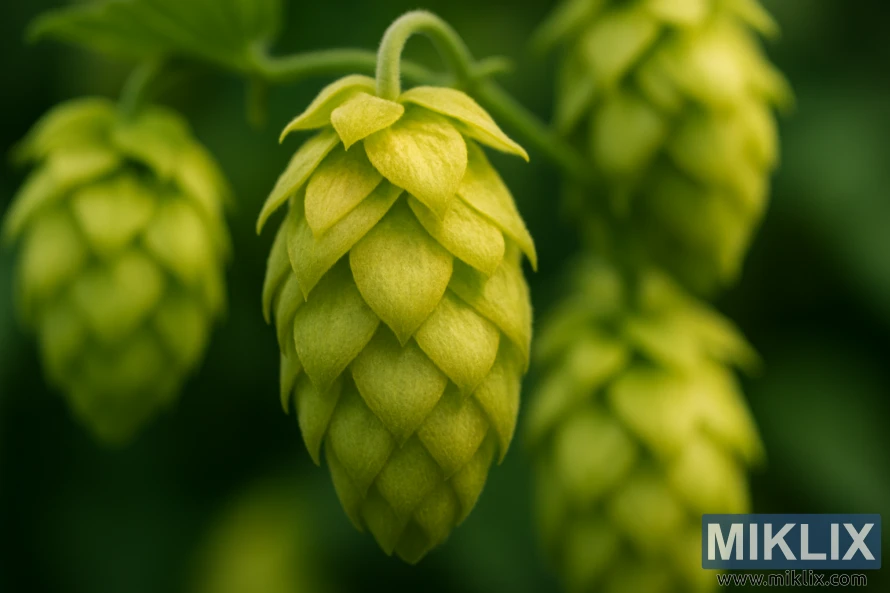
As a dual-purpose hop, Apolon excels in both bittering and aroma applications. It boasts alpha acids ranging from 10–12%, beta acids around 4%, and total oils between 1.3 and 1.6 mL per 100 g. Myrcene is the dominant oil, making up about 62–64%. This profile makes Apolon appealing for brewers aiming to enhance myrcene without compromising on bitterness.
Despite a decline in cultivation, Apolon remains commercially viable. It is an excellent choice for American craft brewers looking to diversify their hop selection. This article will dive into Apolon's agronomy, chemistry, flavor, and practical applications in brewing.
Key Takeaways
- Apolon hops are a Slovenian selection from the 1970s, bred at Žalec.
- The Apolon hop variety is dual-purpose with ~10–12% alpha acids and a myrcene-rich oil profile.
- Its chemistry supports both bittering and aroma roles in beer recipes.
- Commercial cultivation has declined, but Apolon remains useful for craft brewers.
- This article will explore agronomy, flavor, brewing techniques, and sourcing.
Overview of Apolon Hops
Apolon, a Slovenian hybrid hop, comes from the Super Styrian lineage. It's a workhorse in the brewhouse, used for bittering and late additions. This brings out floral and resinous notes in beers.
The Apolon hop summary reveals moderate alpha acids, typically 10–12%, averaging around 11%. Beta acids are about 4%, and co-humulone is low, around 2.3%. Total oils range from 1.3 to 1.6 mL per 100 g, ideal for aromatic use in ales.
As a dual-purpose Slovenian hop, Apolon was bred for bittering but excels in aroma roles. It's perfect for ESB, IPA, and various ales. It offers clean bitterness and subtle floral-resin aroma.
- Production and availability: cultivation has declined and sourcing can be difficult for large-scale buyers.
- Primary metrics: alpha acids ~11%, beta acids ~4%, co-humulone ~2.3%, total oils 1.3–1.6 mL/100 g.
- Typical applications: bittering base with utility for late additions and dry hopping.
Despite reduced acreage, Apolon remains viable for craft and regional brewers. It's a versatile hop. The Apolon hop summary aids in balancing bittering with aroma in beer recipes.
Botanical and Agronomic Characteristics
Apolon was developed at the Hop Research Institute in Žalec, Slovenia, by Dr. Tone Wagner in the early 1970s. It came from seedling selection No. 18/57, a cross between Brewer’s Gold and a Yugoslavian wild male. This makes Apolon a part of Slovenian hop cultivation, but also a deliberate hybrid selection.
Classification records show Apolon was reclassified from the “Super Styrian” group to a recognized Slovenian hybrid. This change highlights its regional breeding history and its fit with local growing systems. Growers should note its late seasonal maturity when considering Apolon agronomy.
Field reports describe hop growth traits as vigorous, with growth rate ranging from high to very high. Yield figures vary by site, but documented averages sit near 1000 kg per hectare, or about 890 lbs per acre. These numbers offer a realistic baseline for estimating commercial output in comparable climates.
On disease resistance, Apolon demonstrates moderate tolerance to downy mildew. This level of resilience can reduce spray frequency during wet seasons, yet integrated pest management remains important. Observations from Slovenian hop cultivation stress routine monitoring to maintain crop health.
Cone characteristics such as size and density are inconsistently reported, reflecting reduced planting area and limited recent trials. Storage behavior shows mixed results: one source notes Apolon retains roughly 57% of alpha acids after six months at 20°C (68°F). Another source lists a Hop Storage Index near 0.43, which suggests relatively poor long-term stability.
For growers weighing Apolon agronomy, the combination of strong hop growth traits, modest yield, and moderate disease resistance frames a clear agronomic profile. Practical choices about harvest timing and post-harvest handling will affect alpha acid retention and marketability.
Chemical Profile and Brewing Values
Apolon alpha acids range from 10–12%, averaging around 11%. This makes Apolon a popular choice for bittering hops. It offers a reliable bitterness without overloading the IBUs.
The beta acid content of Apolon is roughly 4%. While beta acids don't contribute to bitterness in hot wort, they influence the hop resin profile. This affects aging and stability.
Co-humulone Apolon is notably low, at about 2.25% (2.3% average). This low co-humulone content suggests a smoother bitterness compared to many other varieties.
- Total oils: 1.3–1.6 mL per 100 g (average ~1.5 mL/100 g).
- Myrcene: 62–64% (avg 63%).
- Humulene: 25–27% (avg 26%).
- Caryophyllene: 3–5% (avg 4%).
- Farnesene: ~11–12% (avg 11.5%).
- Trace compounds include β-pinene, linalool, geraniol, selinene.
The hop oil composition of Apolon is rich in resinous, citrus, and fruity notes, thanks to myrcene dominance. Humulene and caryophyllene add woody, spicy, and herbal layers. Farnesene contributes green and floral notes, enhancing aroma when used in late boil or dry hopping.
HSI Apolon values show sensitivity to freshness. HSI numbers are near 0.43 (43%), indicating significant alpha and beta loss after six months at room temperature. Another measure found Apolon retained about 57% of alpha acids after six months at 20°C.
Practical brewing implications: Use Apolon early for consistent bittering where alpha acids are crucial. Add later touches or dry hops to showcase the hop oil composition and preserve volatile aromatics. Store cold and sealed to minimize HSI-related decline and preserve resin and aroma character.
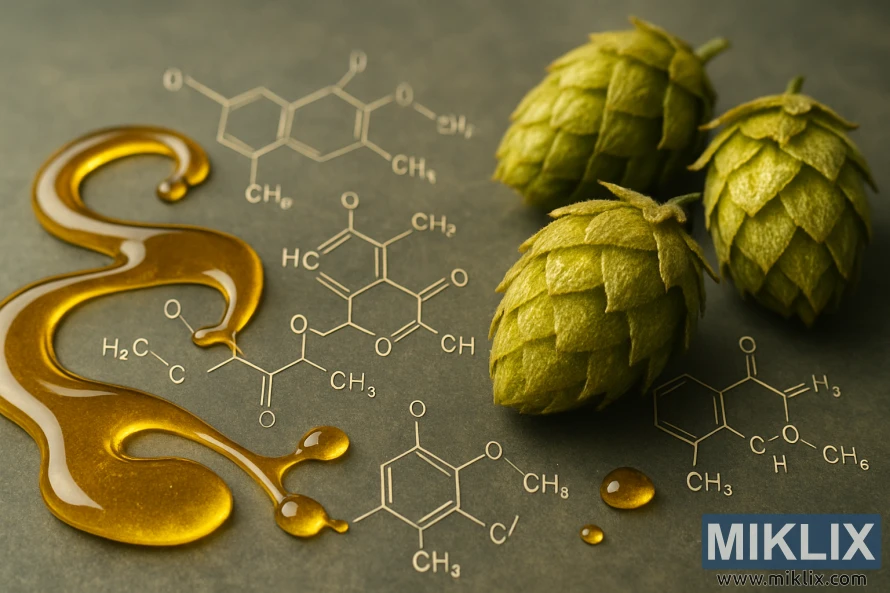
Apolon hops
Apolon hops have their roots in Central European breeding programs. Initially known as Super Styrian in the 1970s, they were later reclassified as a Slovenian hybrid. This shift in naming explains the discrepancies in older catalogs, where the same cultivar is listed under different names.
Breeders have grouped Apolon alongside its siblings, Ahil and Atlas. These hops share a common ancestry, displaying similarities in bitterness and aroma. For brewers interested in hop lineage, recognizing these genetic ties can enhance their understanding of hop character.
The commercial availability of Apolon hops is restricted. Unlike Cascade or Hallertau, which are grown on a large scale, Apolon is less common. It is available in whole cone or pellet form, depending on the harvest year and crop availability from small farms and specialty suppliers.
Availability can fluctuate based on the season and vendor. Online marketplaces occasionally list Apolon in small quantities. Prices and freshness are directly tied to the harvest year. It's crucial for buyers to verify the crop year and storage conditions before making a purchase.
Currently, Apolon is offered in traditional formats: whole cone and pellet. There are no lupulin powder or concentrated cryo products available for this cultivar at this time.
- Typical formats: whole cone, pellet
- Related varieties: Ahil, Atlas
- Historic label: Super Styrian hops
When exploring small-batch recipes, it's essential to include Apolon hop facts. This ensures that you're aware of the availability and lab analysis. Understanding Apolon's identity helps in matching it to a brewing profile or finding suitable substitutes if it's in short supply.
Flavor and Aroma Profile
Apolon flavor is marked by a myrcene-driven signature when cones are fresh. The initial impression is resinous, with bright citrus notes that evolve into stone fruit and light tropical hints. This makes Apolon flavor ideal for late kettle additions and dry hopping, where volatile oils can truly shine.
The Apolon aroma on the nose is a perfect balance of resin and woodiness. Humulene provides a dry, noble-spice backbone. Caryophyllene adds subtle pepper and herbal accents, rounding out the profile. The combination of oils emphasizes both piney resin and bright citrus peel, often described as pine citrus resin hops.
In the finished beer, expect a layered contribution. The citrus lift is upfront, followed by a resinous mid-palate, and a woody-spice finish. The farnesene fraction adds green and floral highlights, differentiating Apolon from other high-alpha varieties. Low cohumulone ensures a smooth bitterness without harshness.
- Rubbed cones: strong myrcene hops character, citrus and resin.
- Kettle/late additions: build aroma without excessive bitterness.
- Dry hop: amplifies pine citrus resin hops traits and volatile oils.
Compared to other bittering varieties, Apolon shares similar alpha strength but excels in oil balance. The presence of farnesene and the mix of myrcene, humulene, and caryophyllene create a complex, layered aroma. Brewers seeking both bittering reliability and aromatic depth will find Apolon flavor versatile in many beer styles.
Brewing Techniques with Apolon
Apolon is a versatile hop, suitable for both early boil bittering and late additions for aroma. Its 10–12% alpha acids contribute a smooth bitterness, thanks to its low cohumulone content. The myrcene-dominant oils impart a resinous, citrus, and woody character when retained.
For bittering, treat Apolon like other high-alpha varieties. Calculate the necessary additions to achieve your desired IBUs, taking into account hop storage index and freshness. Standard utilization in a 60-minute boil is expected, so plan your Apolon additions carefully.
Late boil and whirlpool additions are ideal for capturing volatile oils. Add Apolon at flameout or during a 15–30 minute whirlpool at 170–180°F to preserve myrcene and humulene. A small whirlpool charge can enhance aroma without introducing harsh grassy notes.
Dry hopping accentuates the resinous and citrus aspects of Apolon. Use it in 3–7 g/L ranges for noticeable aroma in ales. The availability and cost of Apolon may influence your dry hopping strategy, so balance these factors when planning your additions.
- Primary bittering: standard IBU math using 10–12% alpha acids.
- Late/whirlpool: add at flameout or in a cool whirlpool for aroma retention.
- Dry hop: moderate rates for resinous-citrus lift; consider blend partners.
There are no commercial cryo or lupulin formats for Apolon. Work with whole cone or pellet forms, scaling rates according to the material's pasteurization or freshness. When blending, pair Apolon with clean bases like Citra, Sorachi Ace, or traditional noble hops to balance bitterness and aroma.
Adjusting Apolon hop additions depends on the beer style and malt bill. For IPAs, increase late and dry-hop doses. For lagers or pilsners, use more early bittering and less late to maintain a cleaner profile. Monitor outcomes and adjust timing and grams per liter across batches for consistent results.
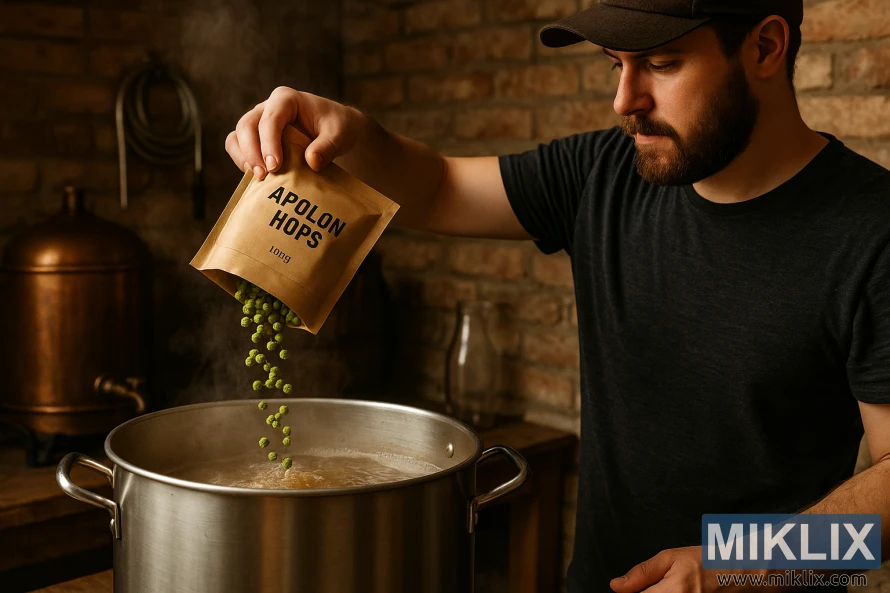
Best Beer Styles for Apolon
Apolon excels in beers needing firm bitterness and a citrusy kick. It's perfect for IPAs, providing a solid bitterness while adding pine and citrus notes. Dry hopping with Apolon in double IPAs enhances the aroma without overpowering the hop mix.
In traditional British ales, Apolon ESB is ideal for a balanced bitterness. It adds a subtle citrus note and a rounded bitterness, fitting well in session-strength bitters and stronger ESBs.
Strong ales, barleywines, and American-style stouts benefit from Apolon's structure. In dark, malt-forward beers, Apolon offers a firm bittering base and woody, resinous aromas. These complement caramel and roast flavors nicely.
- India Pale Ales: Use Apolon for IPAs early for bittering, late for aroma. Combine with Citra or Simcoe for layered citrus and pine.
- Extra Special Bitter: Apolon ESB creates classic bitterness with a cleaner, fruitier finish.
- Strong ales and barleywines: Add Apolon to balance malt sweetness and lend a resinous edge.
- American-style stouts: Use modest amounts for bittering and a hint of woody resin without brightening the roast too much.
Many commercial brewers choose hops with high alpha acids and citrus-pine character for similar effects. Beers with Apolon are robust and hop-forward yet remain drinkable across various strengths.
Substitutions and Blend Partners
When searching for Apolon substitutes, rely on data-driven similarity rather than guesswork. Utilize hop comparison tools that align alpha acids, oil composition, and sensory descriptors. This method helps find close alternatives.
Seek hops with alpha acids around 10–12 percent and a myrcene-forward oil profile. These characteristics provide a similar resinous bite and citrus backbone. Brewer’s Gold, being a parent variety, serves as a useful reference when looking for hops to replace Apolon.
- For bittering purposes, choose dual-purpose, high-alpha resinous hops that mirror Apolon’s backbone.
- For aroma adjustments, select hops with matching myrcene and moderate humulene to maintain balance.
Hop blending with Apolon is most effective when Apolon is used as a structural hop. Utilize it for early bittering and pair late additions to enhance complexity.
Pair with tropical or fruity varieties to layer flavor. Citra, Mosaic, and Amarillo offer bright, expressive top notes that contrast the resinous core. This contrast enhances perceived depth without obscuring Apolon’s character.
For woody or spicy complements, choose hops richer in humulene or caryophyllene. These partners add savory echoes that frame Apolon’s citrus-resin profile.
- Decide the role: backbone bittering or aroma accent.
- Match alpha acids and oil strengths when substituting.
- Blend late additions to sculpt the final aroma.
Always test small-scale batches before scaling. Availability and cost can change frequently. Staying flexible with hops to replace Apolon preserves recipe intent while keeping production practical.
Storage, Freshness, and Lupulin Availability
Apolon storage significantly impacts brewing outcomes. An Apolon HSI near 0.43 indicates significant aging at room temperature. Lab data reveal about 57% alpha retention after six months at 20°C (68°F). This highlights the importance of monitoring hop freshness Apolon.
Effective storage involves keeping hops cold and oxygen-free. Vacuum-sealed or nitrogen-flushed packaging slows alpha acid and volatile oil degradation. Refrigeration is suitable for short-term use. Freezing, with vacuum or inert gas, offers the best preservation for longer storage.
Lupulin availability for Apolon is currently restricted. Major cryo products from Yakima Chief, LupuLN2, or Hopsteiner are not available for this variety. There is no lupulin powder Apolon available in the market. Most suppliers offer Apolon as whole-cone or pellet products only.
- Check harvest year and batch notes when buying to compare hop freshness Apolon across suppliers.
- Request storage history if alpha stability or Apolon HSI is important for your recipe.
- Buy pellets for compact storage; buy fresh cones for aroma-forward, short-run projects.
For brewers considering long-term storage versus immediate use, frozen, inert-packaged hops offer consistent bitterness and aroma. Keeping records of purchase date and storage conditions helps track degradation. This practice ensures lupulin powder Apolon, if introduced later, can be compared against known baselines.
Sensory Evaluation and Tasting Notes
Start your hop sensory evaluation by smelling whole cones, lupulin powder, and wet-dry samples. Record your immediate impressions, then note any changes after brief aeration. This method highlights volatile terpenes like myrcene, humulene, caryophyllene, and farnesene.
Tasting involves three layers. Top notes introduce resinous citrus and bright fruit, driven by myrcene. Mid notes reveal woody and spicy elements from humulene, with peppery, herbal accents from caryophyllene. Base notes often show fresh green and faint floral traces from farnesene.
When assessing bitterness, focus on co-humulone and alpha acid impact. Apolon tasting notes suggest a smooth bitterness profile due to low co-humulone near 2.25%. Alpha acid levels provide a firm bittering backbone, ideal for early boil additions.
Evaluate aroma contributions in finished beer by comparing late additions and dry hopping to early bittering additions. Late or dry-hop use delivers layered citrus, resin, and woody aromas. Early additions add clean, stable bitterness with less volatile aroma retention.
Freshness is crucial. Older hops lose volatile aromatics, appearing muted on an Apolon sensory profile. Store hops cold and vacuum sealed to preserve bright citrus and resin notes for accurate hop sensory evaluation during tasting sessions.
- Smell: citrus, resin, fruity top notes.
- Taste: woody spice, peppery herbal mid notes.
- Finish: green floral hints, smooth bitterness.
Purchasing Apolon Hops
Searching for Apolon hops begins with reputable hop merchants and brewing suppliers. Many brewers seek out specialty hop houses, regional distributors, and online marketplaces like Amazon. Availability of Apolon hops changes with the season, harvest year, and the seller's stock levels.
Ensure you receive clear lot data when ordering. Request the harvest year, alpha-acid and oil analyses, and a measured HSI or freshness report for the batch. This information is crucial for matching bitterness and aroma expectations.
Consider the form you need before making a purchase. Whole cones and pellets have different storage and dosing requirements. Inquire about vacuum-sealed or nitrogen-flushed packs and cold shipping practices from your chosen suppliers.
Be aware of limited supply from some vendors. The decline in Apolon cultivation has led to scarcity, impacting pricing and distribution. For large brews, confirm stock and lead times with suppliers to avoid delays.
- Verify alpha and oil analysis for the lot you will receive.
- Confirm packaging: vacuum-sealed or nitrogen-flushed is best.
- Choose whole cone or pellet based on your process and storage.
- Ask about cold-chain handling for long shipments.
Currently, lupulin powder or cryo-style products are not available for Apolon. Plan your recipes and hop schedules around whole or pellet forms. When purchasing Apolon hops, contact multiple suppliers to compare prices, harvest years, and shipping terms for the best deal.
Historical Context and Genetic Lineage
The Apolon's journey began in the early 1970s at the Hop Research Institute in Žalec, Slovenia. It started as seedling selection No. 18/57, created for the local climate and brewing requirements.
The breeding process involved a strategic cross between an English cultivar and local genetics. A Yugoslavian wild male was crossed with Brewer’s Gold. This combination endowed Apolon with a robust bittering profile and disease resistance, ideal for central European conditions.
Dr. Tone Wagner played a pivotal role in Apolon's development. He identified the most promising seedlings and guided the variety through trials. Wagner's efforts also led to the creation of sibling cultivars used in nearby breeding projects.
In the 1970s, Apolon was first introduced to growers as a Super Styrian variety. Later, it was classified as a Slovenian hybrid, highlighting its mixed ancestry. These classifications underscore the breeding goals and regional naming traditions of the time.
- Apolon shares lineage connections with cultivars like Ahil and Atlas, which came from similar programs.
- Those siblings show overlapping traits in aroma and agronomy, useful for comparative breeding.
Despite its potential, Apolon's commercial adoption remained limited. Its acreage decreased over the years as other varieties became more popular. Yet, the records of Apolon's origin and Dr. Tone Wagner's breeding notes are crucial for hop historians and breeders interested in legacy genetics.
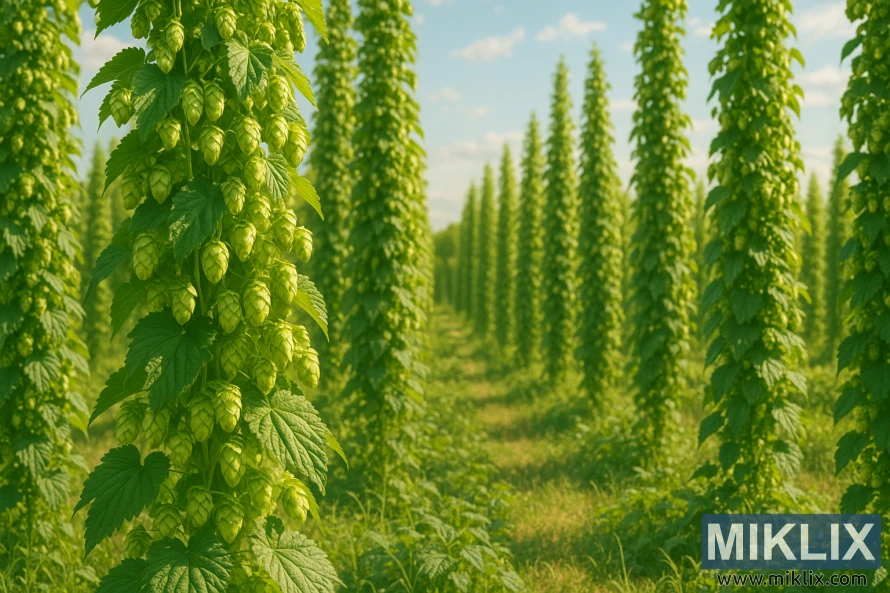
Practical Homebrew Recipes Featuring Apolon
Utilize Apolon as the primary bittering hop in recipes requiring 10–12% alpha acids. Calculate IBUs based on the alpha measured from your lot before brewing. This approach ensures the Apolon IPA and Apolon ESB recipes are consistent and reliable.
Consider a single-hop Apolon ESB to highlight its malty undertones and subtle resin. For an Apolon IPA, employ a firm bittering addition early in the boil. Then, plan late whirlpool or dry-hop additions to enhance citrus and resinous oils.
- Single-hop ESB approach: base malt 85–90%, specialty malts 10–15%, bittering with Apolon at 60 minutes; late kettle additions of Apolon for aroma.
- Single-hop IPA approach: higher ABV base, bittering with Apolon at 60 minutes, whirlpool at 80°C for 15–20 minutes, and heavy dry-hop with Apolon.
- Blended IPA approach: Apolon for backbone plus Citra, Mosaic, or Amarillo for fruit-forward late additions.
Lupulin powder is not available, so use Apolon pellets or whole cones. Prioritize fresh harvests and increase late and dry-hop rates for older hops to compensate for oil loss.
Plan your purchases to match batch sizes. Historical yields are low, leading to potential scarcity. Store Apolon frozen in vacuum-sealed packs to preserve alpha acids and oils for home brewing.
- Measure alpha of your hops on arrival and recalc IBUs.
- Bitter with Apolon at 60 minutes for stable backbone.
- Add Apolon at whirlpool and dry-hop to showcase citrus and resin.
- Blend with fruit-forward varieties when you want more tropical top notes.
Small adjustments in timing and quantity allow you to fine-tune an Apolon IPA recipe. You can aim for bright bitterness or a resinous aroma. The same approach applies to an Apolon ESB recipe, aiming for malt balance without obscuring hop character.
Keep detailed notes on each batch. Record alpha values, boil additions, whirlpool temps, and dry-hop durations. Such records are invaluable for replicating a favorite recipe when brewing with Apolon at home.
Commercial Use Cases and Brewer Examples
Apolon excels among craft and regional brewers, offering a balance of bittering and citrusy aromatics. Small to mid-size breweries prefer Apolon for its low cohumulone bitterness. This characteristic ensures a smooth flavor even after extended tank times.
IPAs, extra special bitters, and strong ales are common uses for Apolon. Its myrcene-led aromatics bring pine and light citrus notes. This makes it ideal for dry-hopped IPAs or as a base hop with fruit-forward varieties.
Specialty batches and seasonal releases frequently showcase Apolon. Some craft brewers obtain it from Slovenian suppliers for experimental brews. These trials provide valuable insights for recipe refinement and scaling.
Large commercial brewers face operational hurdles in adopting Apolon. Supply constraints, due to cultivation decline, limit its availability. As a result, Apolon is more prevalent among boutique producers than national brands.
- Use: reliable bittering with resinous aroma for IPAs and strong ales.
- Blend strategy: pair with citrusy hops for complexity in American-style beers.
- Procurement: sourced from specialty hop merchants; check harvest year for freshness.
In commercial beers, Apolon often serves as a supporting ingredient. This approach preserves its unique character while enhancing the beer's overall aroma. It allows brewers to create complex flavors without overpowering the malt.
Craft-focused Apolon case studies offer valuable lessons. They detail best practices for dosage, timing, and dry-hop combinations. These insights help brewers achieve consistent bitterness and a pleasant finish, even when scaling up from pilot batches.
Regulatory, Naming, and Trademark Notes
The history of Apolon naming is complex, affecting brewers and suppliers. Initially known as Super Styrian, it was later reclassified as the Slovenian hybrid Apolon. This change has led to confusion in older research papers and catalogs.
When purchasing hops, it's crucial to avoid confusion with similar-sounding names. Apolon should not be confused with Apollo or other varieties. Clear labeling is essential to prevent errors and ensure the correct hop varieties are delivered.
Commercial availability of Apolon differs from major brands. Unlike Apollo and some U.S. varieties, Apolon lacks a widely recognized lupulin or cryo product. This means buyers usually receive conventional leaf, pellet, or breeder-specific processed forms.
Legal protections are in place for many cultivars. In Europe, North America, and other regions, hop cultivar registration and plant breeders’ rights are common. Suppliers should provide registration numbers and breeding credits for Apolon to ensure legal use.
Import and export processes require careful documentation. Phytosanitary certificates, import permits, and declared cultivar names are necessary for international hop shipments. Ensure all documentation is in order before making cross-border purchases to avoid customs delays.
- Check naming history to reconcile older references to Super Styrian with current Apolon naming.
- Confirm that products are not misbranded among similar-sounding varieties like Apollo.
- Ask suppliers about hop cultivar registration and any applicable breeders’ rights.
- Request phytosanitary and import documents when importing hops into the United States.
By following these guidelines, brewers can ensure compliance and transparency in their hop sourcing. This approach maintains best practices without relying on a single trademarked supply chain.
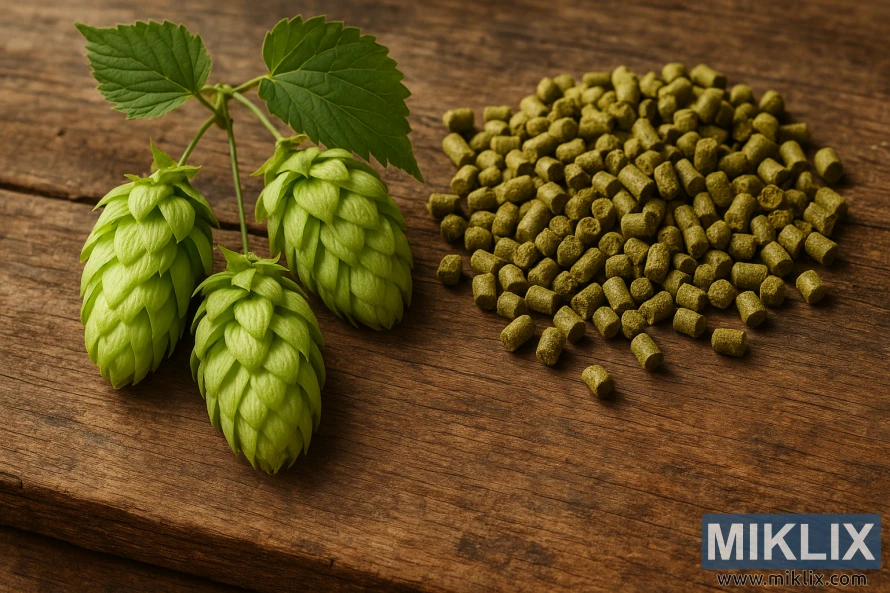
Conclusion
This Apolon summary encapsulates its origins, chemical makeup, and brewing applications. Developed in Slovenia by Dr. Tone Wagner in the early 1970s, Apolon is a versatile hop. It boasts alpha acids of 10–12%, low co-humulone near 2.25%, and total oils of 1.3–1.6 mL/100g, with myrcene dominating at ~63%. These characteristics significantly influence its use in brewing.
Practical insights into Apolon brewing are straightforward. Its bitterness is consistent, and its aroma is best preserved when added late or as a dry-hop. The absence of lupulin or cryogenic Apolon products necessitates careful handling, storage, and supplier verification to maintain its potency and aroma.
When planning IPAs, ESBs, and strong ales, the Apolon hop guide is invaluable. It's perfect for beers needing a resinous, citrusy backbone. Blending it with fruit-forward hops can enhance complexity. Always check supplier availability and storage history before purchasing, as freshness and scarcity impact its performance more than other common hops.
Further Reading
If you enjoyed this post, you may also like these suggestions:
